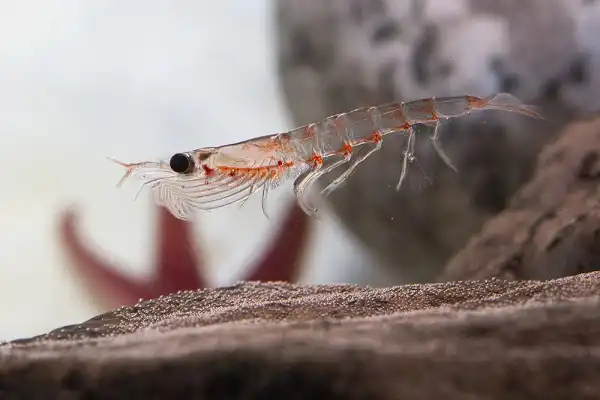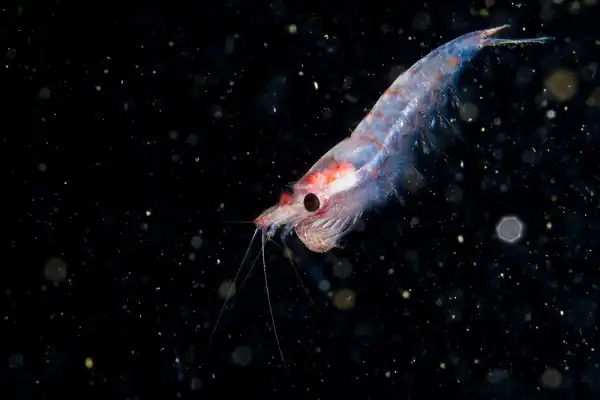Krill, a tiny but mighty species of marine invertebrate, are the unsung heroes of the sea. These small crustaceans form the foundation of oceanic food webs and support an incredibly wide variety of wildlife populations around the world. From whales to fish, birds, and other aquatic life, krill have become one of nature’s most vital nutrients. Despite their importance in maintaining healthy ecosystems and fisheries, however, these little creatures often go overlooked. In this blog post, we will dive into why krill matter so much and explore ways to protect them for future generations.

Krill Description
Krill are small, shrimp-like marine invertebrates that belong to the family Euphausiacea. They are found in oceans all around the world but are particularly abundant in colder waters, such as those around Antarctica. They are filter feeders, meaning that they eat by straining tiny plants and animals from the water around them. Despite their tiny size, they are incredibly abundant – in fact, it is estimated that the total biomass of krill in the world’s oceans is greater than that of all humans on Earth.
Krill Habitat
Krill inhabit almost every ocean in the world, but they are most commonly found in cold waters, such as those surrounding Antarctica. They are known to form incredibly dense swarms near the surface of the water, which can span several kilometers in width and depth. These swarms can contain millions of individual krill and can be so large that they are visible from space. Krill have evolved to live in a wide range of depths and oceanic temperatures and can be found at depths of up to 1,000 meters. They are able to survive in such depths due to their unique circulatory system, which helps them regulate their body temperatures in response to the surrounding water. While krill are highly adaptable and can be found in a variety of oceanic environments, they are particularly sensitive to changes in water temperatures and acidity levels. As such, they are highly susceptible to the impacts of climate change, which is causing changes in the distribution and abundance of krill populations around the world. To safeguard the future of these important marine creatures, it is essential that we take steps to protect their habitats and ensure that they are able to thrive in healthy and sustainable ecosystems.
Krill Diet
Krill are filter feeders, meaning that they consume small particles and organisms that are suspended in the water column. Their diet primarily consists of phytoplankton, which are tiny plants that float near the surface of the water. However, krill will also consume other small organisms, such as zooplankton, as well as detritus and other organic matter. Krill are able to filter feed by pumping large volumes of water through their mouthparts, which are lined with fine hairs called setae. The setae trap small particles and organisms in the water, which are then transferred to the krill’s esophagus and stomach for digestion. Krill have a high metabolic rate, which means that they require a lot of food to sustain themselves. They typically feed continuously throughout the day and night, consuming up to 9% of their body weight in food each day. This high feeding rate is essential for their survival, as it allows them to build up enough energy reserves to reproduce and survive harsh environmental conditions.

Krill Size
Krill come in a variety of sizes, with the smallest species measuring just a few millimeters in length while the largest can reach up to 6 centimeters in length. Despite their small size, they play a crucial role in the marine food chain and are an essential food source for many larger marine animals, including whales and penguins. One unique feature of krill is their ability to change size depending on their age and environmental conditions. As krill mature and move into deeper waters, they tend to grow larger and develop stronger muscles to withstand the higher water pressure. However, changes in environmental factors such as water temperature and availability of food can also impact their growth and size.
Krill Lifespan
Krill have a relatively short lifespan, typically living for only around 5 to 7 years. However, during this time, they play a critical role in the marine food web by serving as a vital food source for a variety of larger animals. The lifespan of krill is influenced by a number of factors, including the availability of food, water temperature, and predation. Krill that have access to abundant food and ideal water conditions may have a longer lifespan than those that do not. Overall, the lifespan of krill may be relatively short, but their contributions to the marine ecosystem are immense. Ensuring the protection and conservation of krill habitats is critical to maintaining the health and vitality of our oceans and the countless species that depend on them for survival.
Krill Behavior
Kr behavior is a fascinating and complex subject that has captured the attention of marine biologists and enthusiasts alike. These tiny crustaceans display a range of behaviors that are critical to their survival and play a vital role in the marine food chain. One of the most remarkable aspects of krill behavior is their ability to gather in massive swarms, known as blooms or bands. These swarms can extend for miles and are a spectacular sight to behold. Krill typically form these swarms in response to environmental factors such as temperature, light, and nutrient availability. Krill are also known for their vertical migration patterns, where they move up and down in the water column in response to changing light conditions.
During the daytime, krill stay in deeper waters to avoid predators and seek out cooler temperatures, while at night they move up to the surface layers of the water where they can feed on phytoplankton and avoid predators that hunt in the deeper waters. Krill also display a range of social behaviors, including aggression and courtship rituals. Males will fight each other for access to females during mating season, and both males and females will engage in elaborate courtship displays to attract a mate.

Krill Speed
Krill speed is a crucial aspect of their behavior that allows them to thrive in the marine ecosystem. Despite their small size, these tiny crustaceans are capable of swimming at impressive speeds, making them elusive prey for their predators. Krill have been observed swimming at speeds of up to 60 centimeters per second, which is relatively fast considering their size. This speed allows them to quickly evade predators that hunt in the deeper waters and also helps them to move rapidly towards sources of food and nutrients. One of the most remarkable aspects of krill speed is their ability to quickly change direction and maneuver through the water. This agility is critical to their survival, as it allows them to evade predators and navigate through complex underwater environments.
Krill Hunting
Krill hunting is a complex and fascinating behavior that plays an essential role in the marine ecosystem. These tiny crustaceans are a vital food source for many larger animals, including whales and seals, and as such, are an important link in the marine food web. Krill hunting is primarily driven by the need to avoid predators and find sources of food and nutrients. At night, krill move up to the surface layers of the water where they can feed on phytoplankton and avoid predators that hunt in deeper waters. However, despite their best efforts to evade predators, krill are still highly sought-after prey. Many animals have adapted specific hunting strategies to catch krill, including baleen whales, which use their massive jaws to filter krill out of the water in large quantities.
Krill Types
Krill are an important species to the marine ecosystems, and there are numerous types of krill that live throughout the world’s oceans. The most common type is Euphausia superb, or Antarctic krill, which lives in the Southern Ocean around Antarctica and makes up a large portion of the global krill population. Other types of krill include Northern krill (Meganyctiphanes norvegica), temperate-water krill (Thysanoessa raschii), deep-sea krill (Gonionemus vertens) and others. Each type of krill has different feeding habits, habitats, behaviors and predators. Regardless of the species, all types of krill are an important part of the marine ecosystem, and protect in their preservation is essential to maintaining the health and biodiversity of our oceans.

Conclusion
Krill speed and hunting behavior are essential to their survival in the marine ecosystem. Their ability to quickly change direction and evade predators, as well as their reliance on speed and agility when hunting for food, make them a critical link in the marine food web. Unfortunately, krill populations are under threat from human activities such as overfishing and climate change. To ensure the continued health of our oceans, it is essential that we take action to protect krill habitats and populations. By doing so, we can help to preserve the health and biodiversity of our oceans for future generations.
Frequently Asked Question


